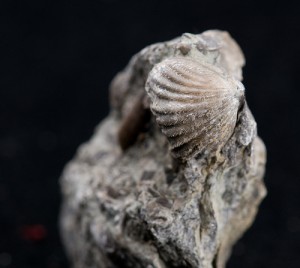Scientists use climate proxies, or preserved physical characteristics of the past, to reconstruct ancient climates. In this article, we’ve included lessons that allow students to explore three examples of climate proxies: tree rings, fossils, and ice cores. We’ve also included a few lessons that introduce climates of the recent and distant past to students.
Because these are complex topics for young learners, elementary teachers should focus on helping students understand that Earth’s climate has been different in the past and that scientists can use certain records to reveal its history.
For each science lesson, we’ve included the appropriate content standard from the National Science Education Standards. You can read the entire National Science Education Standards online for free or register to download the free PDF. The content standards are found in Chapter 6.
Evidence of Past Climates
Tree Rings
Tree Rings as Records of the Past (Grades 1-5)
In this lesson, students observe sections from a tree and determine its age by counting the rings. Older students compare their observations with precipitation records to see if the narrowest rings coincide with years of low rainfall. This lesson meets the Science as Inquiry and Life Science content standards of the National Science Education Standards.
Tree-ring Dating (Grade 5 and up)
Students use activity sheets and discussion to apply principles of dendrochronology, usually called tree-ring dating, to determine a tree’s age and to recognize climatic variation. They will also learn how archaeologists can sometimes use tree rings to date archaeological evidence. This activity meets these content standards of the National Science Education Standards: Science as Inquiry, Life Science, and History and Nature of Science.
Trees: Recorders of Climate Change (Grade 5 and up)
In this lesson, students interpret tree-ring data to discover when the Little Ice Age occurred. This lesson meets the following content standards of the National Science Education Standards: Science as Inquiry, Earth and Space Science, and History and Nature of Science.
Global Change: Time and Cycles (Grade 5 and up)
In this lesson, students analyze simulated core samples (strips of paper with banding patterns) to determine the tree’s age, the year the tree was cut, the year growth began, and good and bad years in terms of environmental conditions. They create a timeline showing these events and may add in historical data as well. This lesson meets the following content standards of the National Science Education Standards: Science as Inquiry and Life Science.
Fossils
Examining Your Fossil (Grades 3-5; modify for Grades K-2)
With a hand lens, students will look at the fossils they made in a related lesson and draw conclusions about the environment in which the fossil was formed. This lesson meets the National Science Education Standards content standards Science as Inquiry and Earth and Space Science.
Suggested modifications for Grades K-2:
Interview students about their fossil after they examine it. A teacher or a helper could record student responses from the oral interview. To support students in the transition from drawing to writing, use Drawing a Story: Stepping from Pictures to Writing, a lesson from ReadWriteThink.
Fossils (Grades 3-5)
Students will act as paleontologists and attempt to figure out the environment in which various fossils would have existed. This lesson meets the National Science Education Standards content standards Science as Inquiry and Earth and Space Science.
Ice Cores
Ice Cores (Grades 3-5)
Scroll down the page to find the activity that uses frozen water balloons (called ice balloons) to represent ice cores. Students observe the air bubbles trapped in the ice and discuss how similar bubbles help scientists understand past climates. This activity meets the Earth and Space Science and History and Nature of Science content standards of the National Science Education Standards.
Frozen in Time: Ice Cores (Grades 4-5)
In this lesson, students observe and measure cans of frozen water, prepared by the teacher, to simulate the study of ice cores by glaciologists. They count the number of years of snow accumulation represented in their cores and graph their data to discover trends in annual snowfall. This lesson meets the Science as Inquiry, Physical Science, Earth and Space Science, and History and Nature of Science content standards of the National Science Education Standards.
Ice Cores: Modeling Ice Sheets (Grade 5 and up)
Students working in groups use common materials to create layers representing stratification of snow and ice. Groups exchange their layers and extract and analyze core samples. This lesson meets the Earth and Space Science and History and Nature of Science content standards of the National Science Education Standards.
Earth’s Climate in the Past
Ice Age Woolly Mammoth Habitat (Grades K-1)
In this lesson, students explore the habitat of the woolly mammoth and create their own scenes depicting a mammoth in its habitat. The lesson meets the Life Science content standard of the National Science Education Standards.
Ice Age, Hunters, Land Bridge, and Woolly Mammoths Unit (Grades K-2)
This nine-day unit focuses on understanding the Ice Age, the Beringia Land Bridge, and species, like woolly mammoths, that lived during this period. The unit meets the Life Science content standard of the National Science Education Standards.
Dust Bowl Days (Grades 3-5)
This cross-curricular lesson introduces students to the Dust Bowl through photographs, songs, and interviews with people who lived through it. The lesson meets the following content standards of the National Science Education Standards: Life Science and Science in Personal and Social Perspectives.
Living During the Little Ice Age (Grade 5 and up)
Students discover how modest climatic cooling changed life for Europeans during the Little Ice Age. This lesson meets the following National Science Education Standards content standards: Science as Inquiry, Earth and Space Science, and Science in Personal and Social Perspectives.
Investigating Climate Past: The Little Ice Age Case Study (Grade 5 and up)
In this unit, students explore how scientists study climates of the recent and ancient past. Students model the methods of scientists through inquiry activities, investigating real data to learn more about changes in climate over the past millennium. The unit meets the Science as Inquiry and Science in Personal and Social Perspectives content standards of the National Science Education Standards.
This article was written by Jessica Fries-Gaither. Jessica is an education resource specialist at The Ohio State University and project director of Beyond Penguins and Polar Bears. She has taught in elementary and middle school settings. Email Jessica at beyondweather@msteacher.org.
Copyright July 2011 – The Ohio State University. This material is based upon work supported by the National Science Foundation under Grant No. 1034922. Any opinions, findings, and conclusions or recommendations expressed in this material are those of the author(s) and do not necessarily reflect the views of the National Science Foundation. This work is licensed under an Attribution-ShareAlike 3.0 Unported Creative Commons license.




